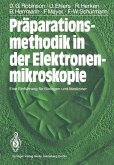Methods of Preparation for Electron Microscopy (eBook, PDF)
An Introduction for the Biomedical Sciences
Übersetzer: Robinson, David G.


Alle Infos zum eBook verschenken

Methods of Preparation for Electron Microscopy (eBook, PDF)
An Introduction for the Biomedical Sciences
Übersetzer: Robinson, David G.
- Format: PDF
- Merkliste
- Auf die Merkliste
- Bewerten Bewerten
- Teilen
- Produkt teilen
- Produkterinnerung
- Produkterinnerung

Hier können Sie sich einloggen

Bitte loggen Sie sich zunächst in Ihr Kundenkonto ein oder registrieren Sie sich bei bücher.de, um das eBook-Abo tolino select nutzen zu können.
In 1939, when the electron optics laboratory of Siemens & Halske Inc. began to manufacture the first electron microscopes, the biological and medical profes sions had an unexpected instrument at their disposal which exceeded the reso lution of the light microscope by more than a hundredfold. The immediate and broad application of this new tool was complicated by the overwhelming prob lems inherent in specimen preparation for the investigation of cellular struc tures. The microtechniques applied in light microscopy were no longer appli cable, since even the thinnest paraffin layers could not be…mehr
- Geräte: PC
- ohne Kopierschutz
- eBook Hilfe
- Größe: 22.96MB
![Advanced Techniques in Biological Electron Microscopy III (eBook, PDF) Advanced Techniques in Biological Electron Microscopy III (eBook, PDF)]() Advanced Techniques in Biological Electron Microscopy III (eBook, PDF)73,95 €
Advanced Techniques in Biological Electron Microscopy III (eBook, PDF)73,95 €![Microinjection and Transgenesis (eBook, PDF) Microinjection and Transgenesis (eBook, PDF)]() Microinjection and Transgenesis (eBook, PDF)40,95 €
Microinjection and Transgenesis (eBook, PDF)40,95 €![Low-Temperature Microscopy and Analysis (eBook, PDF) Low-Temperature Microscopy and Analysis (eBook, PDF)]() Patrick EchlinLow-Temperature Microscopy and Analysis (eBook, PDF)161,95 €
Patrick EchlinLow-Temperature Microscopy and Analysis (eBook, PDF)161,95 €![The Cellular Aspects of Biorhythms (eBook, PDF) The Cellular Aspects of Biorhythms (eBook, PDF)]() The Cellular Aspects of Biorhythms (eBook, PDF)73,95 €
The Cellular Aspects of Biorhythms (eBook, PDF)73,95 €- -55%11
![Präparationsmethodik in der Elektronenmikroskopie (eBook, PDF) Präparationsmethodik in der Elektronenmikroskopie (eBook, PDF)]() David G. RobinsonPräparationsmethodik in der Elektronenmikroskopie (eBook, PDF)35,96 €
David G. RobinsonPräparationsmethodik in der Elektronenmikroskopie (eBook, PDF)35,96 € ![Methods in Endothelial Cell Biology (eBook, PDF) Methods in Endothelial Cell Biology (eBook, PDF)]() Methods in Endothelial Cell Biology (eBook, PDF)161,95 €
Methods in Endothelial Cell Biology (eBook, PDF)161,95 €![New Frontiers in Cytology (eBook, PDF) New Frontiers in Cytology (eBook, PDF)]() New Frontiers in Cytology (eBook, PDF)73,95 €
New Frontiers in Cytology (eBook, PDF)73,95 €-
-
-
Dieser Download kann aus rechtlichen Gründen nur mit Rechnungsadresse in A, B, BG, CY, CZ, D, DK, EW, E, FIN, F, GR, HR, H, IRL, I, LT, L, LR, M, NL, PL, P, R, S, SLO, SK ausgeliefert werden.
- Produktdetails
- Verlag: Springer Berlin Heidelberg
- Seitenzahl: 190
- Erscheinungstermin: 6. Dezember 2012
- Englisch
- ISBN-13: 9783642488481
- Artikelnr.: 53395843
- Verlag: Springer Berlin Heidelberg
- Seitenzahl: 190
- Erscheinungstermin: 6. Dezember 2012
- Englisch
- ISBN-13: 9783642488481
- Artikelnr.: 53395843







